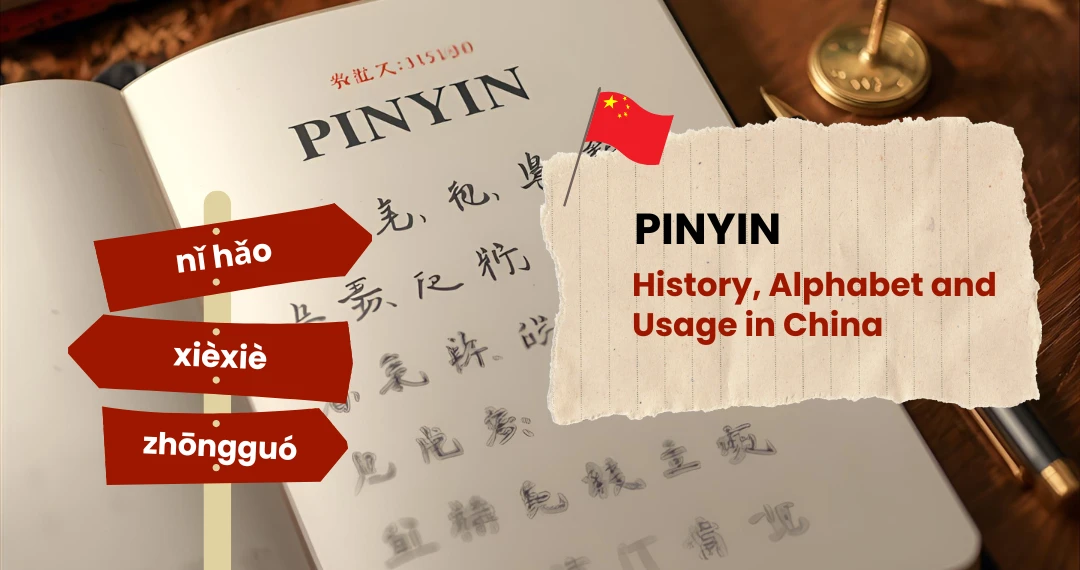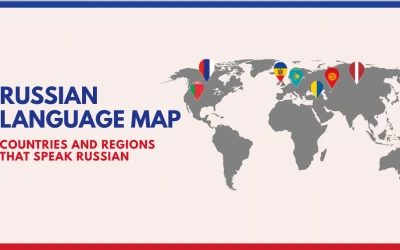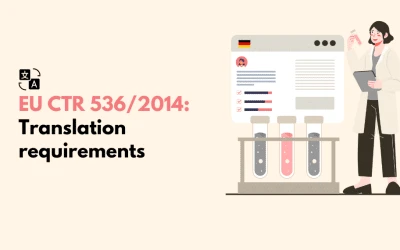Learning Mandarin can feel overwhelming at first, especially with thousands of unique characters. That’s where Pinyin comes in. Developed as a Romanization system, Pinyin uses the Latin alphabet to represent Mandarin sounds, making pronunciation easier for learners worldwide.
In this blog, we’ll explore the history of Pinyin, its alphabet, tones, and essential components, giving you a clear foundation to understand how this system works and why it’s so important in learning Chinese.
What is Pinyin?
Pinyin is the official romanization system for Standard Mandarin Chinese. It uses the Latin alphabet to represent the sounds of Chinese characters, making it easier for learners to read, write, and pronounce Mandarin without needing to know Chinese characters.
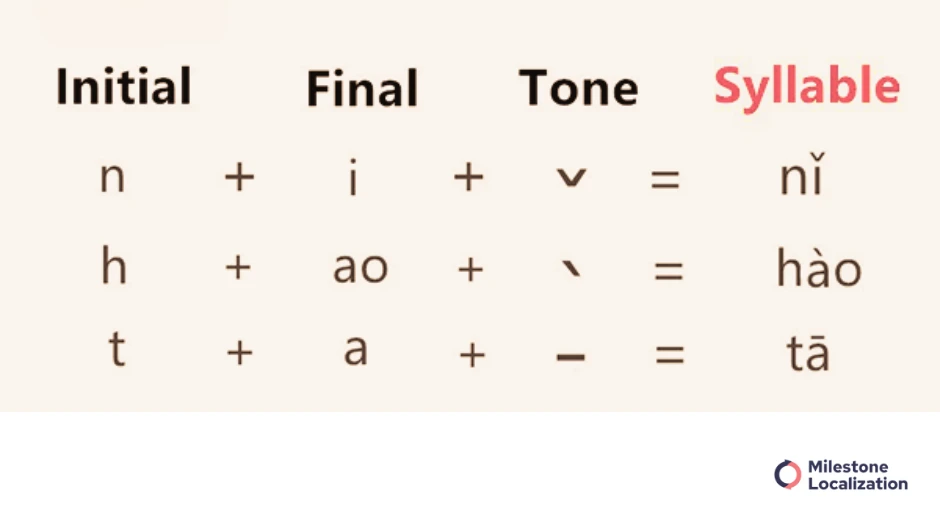
It was created in the 1950s and officially adopted in China in 1958 to standardize the spelling of Mandarin pronunciation.
The History of Pinyin
Why was Pinyin invented?
Pinyin was created to simplify the learning and teaching of Mandarin Chinese while promoting literacy and standardization.
In the 1950s, China faced the challenge of a large population that could not read or write Chinese characters, and Pinyin served as a bridge to help people begin reading and writing phonetically before mastering characters.
Before Pinyin was introduced, there were several systems used to transcribe Chinese sounds. The two most notable ones were:
1: Zhuyin (Bopomofo)
Zhuyin was created in China in the early 20th century and uses unique symbols like ㄅ, ㄆ, ㄇ, and ㄈ to represent sounds.

It uses tone markers ˉ ˊ ˇ ˋ ˙ to denote tones and became the official phonetic script for Mandarin Chinese in 1928.
2: Wade-Giles
This romanization system was developed in the mid-19th century by Thomas Wade and Herbert Giles. It was widely used in the West for academic and linguistic purposes but was often criticized for inconsistencies and confusing spellings.
When was Pinyin invented?
Pinyin was developed in the 1950s to standardize Mandarin pronunciation, simplify learning, and improve literacy, becoming a key tool in modern Chinese language education.
1: 1955: Development begins
In the early years of the People’s Republic of China, raising literacy was a national priority. To support this goal, the government created a committee to standardize Mandarin pronunciation. Zhou Youguang, later called the “Father of Pinyin,” was appointed to lead the project.
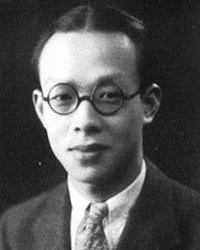
Zhou Youguang
His task was to design a simple, logical system that could make learning Mandarin more accessible to everyone.
2: 1957: System finalized
Within two years, the team completed Hanyu Pinyin. It used the Latin alphabet but assigned specific sounds to letters that matched Mandarin phonetics. This system made it possible to teach correct pronunciation without first knowing Chinese characters.
3: 1958: Official adoption in China
The following year, the government formally adopted Pinyin as the national standard. It was introduced in schools, textbooks, and literacy campaigns, transforming language education and helping unify Mandarin across the country.
Also read: Latin Alphabet: Languages That Use it & Variations
Characteristics of the Pinyin alphabet
1: Initials and Finals
Pinyin is built from 21 initials (consonants) and 36 finals (vowels or vowel combinations). Initials come at the start of a syllable, while finals follow and carry tone marks that define pronunciation.
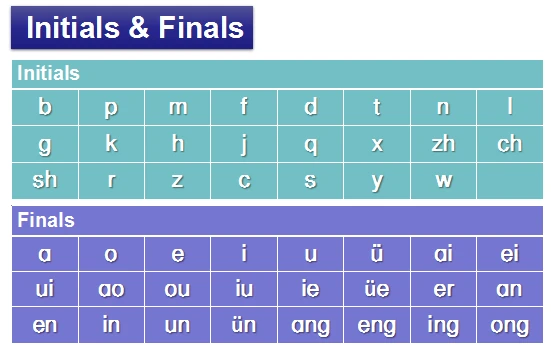
2: Categories of Finals

The 36 finals fall into three groups: simple finals (single vowels), compound finals (two or more vowels combined), and nasal finals (vowels ending with n or ng).
3: Syllable Structure
Each syllable in Pinyin typically combines one initial and one final, corresponding to a single Chinese character. This structure makes Mandarin syllables clear and systematic.
4: Tone System
Mandarin is tonal, and Pinyin represents this with four diacritical tone marks plus a neutral tone with no mark. Since tones change meaning, they are essential for accurate communication.
5: Retroflex Sounds
Letter combinations like zh, ch, and sh represent retroflex consonants. These sounds are unique to Mandarin and are pronounced with the tongue curled back.
6: Semi-Vowels (y and w)
The letters y and w can act as semi-vowels or glides, helping link vowels together smoothly. They are also used when a syllable begins without a regular consonant.
7: Differences from English
Some Pinyin letters look familiar but represent different sounds. For example, q is pronounced like English “ch” and x is close to “sh.” This makes Pinyin specific to Mandarin phonology rather than a direct English equivalent.
8: Tone Mark Placement

Tone marks are always written above the main vowel in a final. This placement ensures clarity and helps distinguish words that would otherwise look identical in spelling.
Looking for Translation services in China?
Difference between Pinyin and Chinese Characters

1: Writing System
Pinyin: Uses the Latin alphabet (a–z) to represent Mandarin sounds. It is a phonetic system.
Chinese Characters: Logographic symbols representing words or morphemes. Each character carries meaning and often reflects cultural or historical context.
2: Purpose
Pinyin: Designed to teach pronunciation, aid literacy, and simplify typing in digital systems.
Chinese Characters: Serve as the official writing system, used in all forms of communication, literature, and media.
3: Pronunciation vs. Meaning
Pinyin: Shows how a word is pronounced but does not convey meaning. Example: mǎ can mean “horse,” while mā means “mother.”
Chinese Characters: Shows meaning directly, but learners must memorize pronunciation separately. Example: 马 = mǎ (horse), 妈 = mā (mother).
4: Learning Curve
Pinyin: Quick and easy to learn, especially for beginners and non-native speakers.
Chinese Characters: Require memorization of thousands of symbols, making literacy more time-consuming.
5: Usage
Pinyin: Used in schools, dictionaries, textbooks, language-learning materials, and typing systems.
Chinese Characters: Used in daily writing, books, newspapers, signage, official documents, and professional communication.
Also read: Simplified vs Traditional Chinese – What’s the Difference?
Is Pinynin used in China?
Yes, Pinyin is extensively used in China today. It is the standard system for teaching Mandarin pronunciation in schools and is widely used for typing Chinese characters on digital devices.
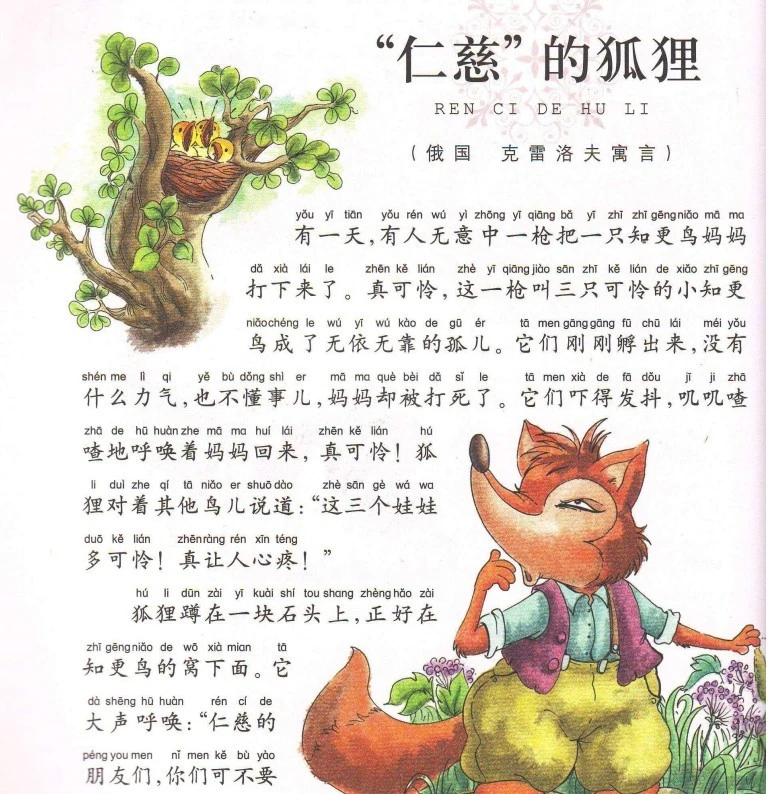
Pinyin in a book for kids
Pinyin facilitates literacy, language learning, and communication both inside China and internationally. It supports input methods for smartphones, computers, and various apps, making it an essential part of modern Chinese daily life and education.
Also read: Doing Business in China: The Cultural Differences You Need to Know
How to read and write Pinyin?
1: Reading Pinyin
To read Pinyin, you need to understand its three main components: initials (consonants), finals (vowels or vowel combinations), and tones. Each syllable usually combines one initial and one final.

Pay close attention to the tone marks above the main vowel, as tones change the meaning of words. Start by pronouncing each syllable slowly, then combine them to form words and sentences.
2: Writing Pinyin
When writing Pinyin, use the Latin alphabet to represent initials and finals, and add the correct diacritical tone mark over the main vowel of each syllable.
Break words into syllables, write each carefully, and include the tone marks to ensure accurate pronunciation. Consistent practice will help you master Pinyin and provide a strong foundation for learning Chinese characters.
Conclusion
Pinyin has become an essential tool for both native speakers and learners of Mandarin. By breaking the language into initials, finals, and tones, it creates a clear framework for pronunciation and learning.
While it doesn’t replace Chinese characters, it serves as a powerful bridge that makes Mandarin more accessible and less intimidating.
Also read: Chinese vs Japanese vs Korean Languages: Similarities & Differences
Are You Looking for Certified Translation services in China?
FAQS
What is Pinyin?
Pinyin is the official Romanization system for Standard Mandarin Chinese. It uses the Latin alphabet with tone marks to represent pronunciation.
Why was Pinyin created?
Pinyin was developed in the 1950s to standardize Mandarin pronunciation, help with literacy, and make Chinese easier to learn for both native speakers and foreigners.
Does Pinyin replace Chinese characters?
No. Pinyin only represents pronunciation. Chinese writing still uses characters (汉字 hànzì), but Pinyin helps learners read and pronounce them correctly.
How many tones does Pinyin have?
Mandarin has four tones plus a neutral tone. Each tone changes the meaning of a word (e.g., mā, má, mǎ, mà all mean different things).
Is Pinyin used in China today?
Yes. Pinyin is widely used in schools, dictionaries, language learning, and typing on phones and computers. Most Chinese people use Pinyin daily for digital input.
Can you learn Chinese just with Pinyin?
Not fully. Pinyin helps with pronunciation and early learning, but to be fluent or literate, you need to learn Chinese characters as well.

